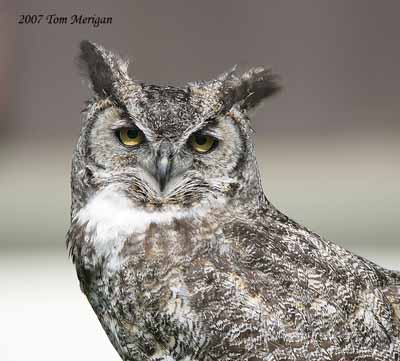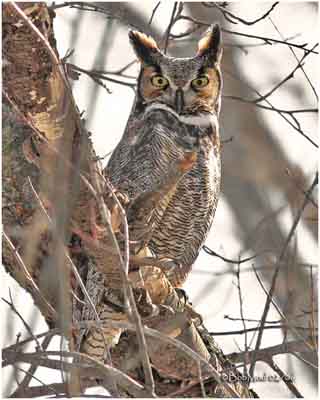
Great Horned Owl
Bubo virginianus
Strigiforme Order – Strigidae Family
BIOMETRICS:
Length : 46-63 cm
Wingspan : 91-152 cm
Weight : Male :1-1,5kg; Female :2-2,5 kg
LONGEVITY: Up to 20 years
DESCRIPTION:
Great Horned Owl is a bulky owl. Its head and its face look like a cat, ears, eyes and shape of the head. It has two feather tufts above the eyes, resembling horns, giving it its name. These tufts have nothing to do with hearing. It uses them as body language. When it is irritated, tufts are flat, when it is inquisitive, they are raised.

Upperparts are brown, mottled with grey brown. Underparts are mostly dark, contrasting with its white throat. Plumage is pale grey with dark bands, except a white band on the throat.
PROTECTION / THREATS / STATUS:
Great Horned Owl is threatened by shooting, traps, road kills and electrocutions.
About 50% of the young that fledge die within their first year from various causes.
It is widespread and locally common, and recognized helping to control pest populations, such as rats and mice.
Fr: Grand duc d’Amérique
All : Virginiauhu
Esp: Búho Americano
Ital: Gufo della Virginia razza scura
Nd: Amerikaanse Oehoe
Russe: Американский филин
Sd: Virginiauv
Photographs by Bob Moul
His website : Nature Photography
Photographs by Tom Merigan
His website : Tom Merigan’s Photo Galleries
Text by Nicole Bouglouan
Sources :
HANDBOOK OF THE BIRDS OF THE WORLD Vol 5 by Josep del Hoyo-Andrew Elliott-Jordi Sargatal - Lynx Edicions - ISBN: 8487334253
FIELD GUIDE TO THE BIRDS OF NORTH AMERICA by National Geographic Society - National Geographic Society - ISBN: 0792274512
All About Birds (Cornell Lab of Ornithology)
Animal Diversity Web (University of Michigan Museum of Zoology)
Wikipédia (Wikipedia, The Free Encyclopedia)
Birds of Nova Scotia (Robie Tufts)
The Hawk Conservancy Trust (Hilary Smith)
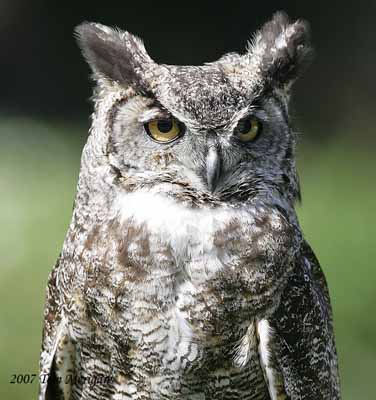
Northern owls are paler, almost whitish, than the southern birds.
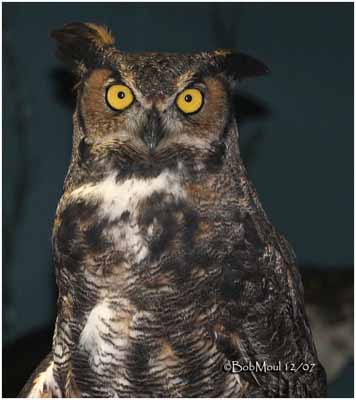
Great Horned Owl has large yellow orange eyes, and an orange buff facial disk, and some white feathers are forming a V between the eyes. They have fixed eyes and they can’t move them, so they can rotate their heads 270 degrees.
Bill is hooked and black.
Great Horned Owl has large feathered legs and feet to the end of the toes. Owls have four toes, three in front and one in back. The outer toe is reversible, giving two in front and two in back, helping the bird to grip a perch or a branch. Its talons clutch the tree branch and keep it from falling off its perch.
Female is similar but larger than male.
Immature resemble adults, with ear tufts smaller or not apparent.
VOICE: SOUNDS BY XENO-CANTO
Great Horned Owl has wide variety of sounds, from deep hoots to shrieks.
Territorial male’s call is a “hoo-hoo-hoooooo-hoo-hoo” carrying far over several miles during the night. Male has lower-pitched sounds than female.
During attacks, when an intruder is found, they utter a “kroooo-oo”, or screams.
But Great Horned Owl can utter several sounds, such as mewing, barks, coos and bill snapping.
HABITAT:
Great Horned Owl lives in dense forests, but also deserts and plains, cliffs and rocky canyons, and urban parks.
RANGE:
Great Horned Owl lives from North America to Central and South America.
BEHAVIOUR:
Great Horned Owl is resident, but northern birds may migrate south.
It becomes active at dusk, and during the night. It has binocular vision, 100 times as powerful as our.
To hunt, Great Horned Owl perches on poles, searching preys. It may also glide just above the ground. When it hunts from high perches, it dives down, with folded wings, before snatching prey. When it grasps it with its talons, it kills instantly its prey.
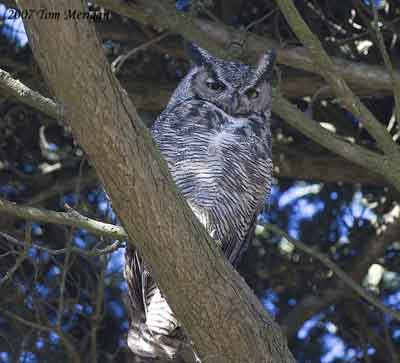
It may hunt walking, to capture small animals, or wading in shallow water to catch frogs and fish. Small preys are swallowed whole, but larger preys are carried off and teared on perches or at nest. Birds are plucked before tearing and eating them. It regurgitates pellets with bones, fur and feathers. They are greyish black and compact, ejected 6 to 8 hours after eating.
Great Horned Owl may hunt preys 2 to 3 times heavier than itself. It spends most of time hunting, sometimes during the day, but it has better vision at night. With its loose and soft feathers, it flies silently, that is very advantageous for it.
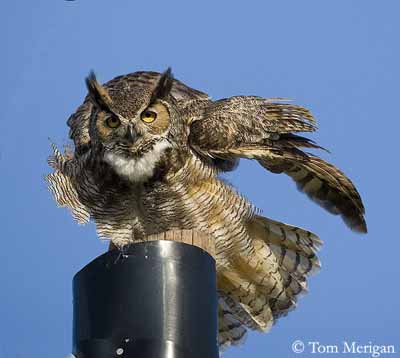
Great Horned Owl may be very hostile when young are at nest. It flies near intruder, snapping its bill and hooting, continuing until intruder is killed or driven off.
Great Horned Owls perform courtship displays, pair hooting, singing love songs between them, bowing to each other with drooped wings. We can see sometimes birds rubbing its bills and preening. The two mates stay together during nesting season, but they are solitary birds out of this period. They roost during the day in rocky caves or in tree limbs.
FLIGHT:
Great Horned Owl flies noiseless with its long wings fringed with sound-lessening filaments at the tip of their flight feathers.
Its flight is rapid and graceful. It may sail in large circles, rise and descend without any difficulty. It may glide silently close to the ground with good velocity.
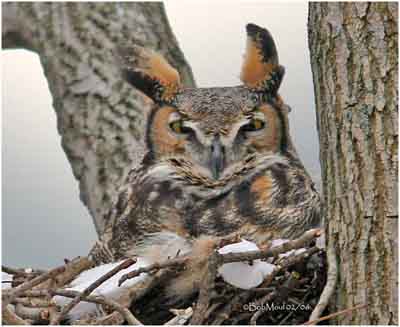
REPRODUCTION:
Great Horned Owl does not build nest. It utilises nests of other birds, such as hawks, crows and herons. It can also use hollows in trees, rocky caves, abandoned buildings or artificial platforms. Nests chosen are bulky and made with sticks, and lined with coarse grasses and feathers.
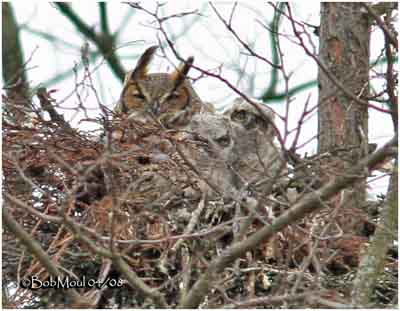
Female lays 2 to 4 white eggs. Incubation lasts about 26 to 35 days, only by female, which is protected and fed by the male during this period. Chicks hatch altricial and covered with white down. Young leave the nest to nearly branches at 6 to 7 weeks. They can fly at 9 to 10 weeks old. Young are fed for few weeks more, and are slowly weaned.
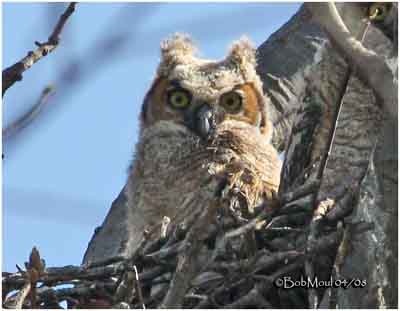
Young disperse in autumn. The same pair may keep its territory for 8 consecutive years, but mates stay together only during the nesting season. Young reach their sexual maturity at two years of age, and they mate for life.
This species produces only one clutch per year.
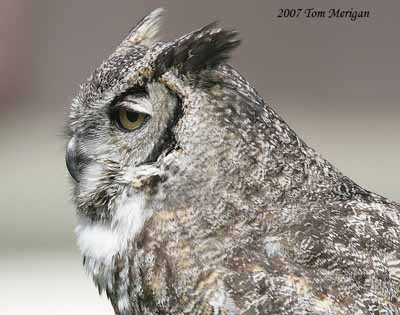
DIET:
Great Horned Owl is among the rare bird eating skunks, proving that it has a bad sense of smell.
Great Horned Owl eats a varied assortment of animal life.
It feeds on mammals (rodents, rabbits, hares, squirrels, raccoons, domestic dogs and cats, porcupines…), birds (owls, grouses, crows, turkeys, Red-tailed Hawks, Great blue Heron, ducks, swans, poultry), reptiles (snakes, turtles, lizards, amphibians, but also young alligators), and others, such as fish, large insects, scorpions, crayfish, worms, spiders…
